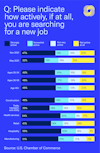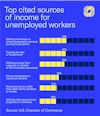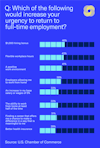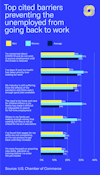America is experiencing a workforce crisis that is slowing the nation’s economic recovery. We first polled unemployed Americans who lost their job during the pandemic in May, and since then, the crisis has worsened. There are 10.4 million unfilled jobs and 7.6 million unemployed Americans, many of whom lost jobs amid the pandemic and have not returned to work.
This has raised important questions: How many unemployed Americans are actively seeking work? How many plan to return to work this year… or ever? And for those unemployed Americans who are seeking work right now, what barriers stand in the way?
Here’s what we heard.
This poll of 529 Americans who became unemployed during the pandemic and have not returned to full-time employment was taken November 2-9, 2021. The poll was conducted in partnership with the Sports & Leisure Research Group.
Key Findings
- More than half (53%) of Americans who became unemployed during the pandemic say they are only somewhat active, or not very active at all, in looking for work.
- Nearly two-thirds (65%) don’t expect to be back working before the new year, and 8% say they never plan to return to work.
- More than one in ten (13%) have left multiple jobs during the pandemic.
- Among those currently unemployed who have held multiple jobs since April 2020, 57% held their most recent position for three months or less.
- Almost half said they have been using pandemic incentives or stimulus payments, or tapping into savings and investments, to get by.
- A third (32%) want and expect to switch industries.
- A hiring bonus of $1,000 remains the top incentive most apt to bring unemployed workers back.
Many Americans who lost their jobs during the pandemic (still) aren’t actively job searching.
More than half (53%) of Americans who became unemployed during the pandemic say they are either somewhat active, not very active, or are not active at all in looking for work. Just under half (47%, up from 32% in May) report that they are strongly active in their job search.
Two-thirds (65%) that lost their job and remain unemployed do not expect to be back at work full time before the start of the new year. One in three are not expecting to return before Q2 2022.

More than one in ten have left multiple jobs during the pandemic.
Over one in ten (13%) unemployed Americans have switched jobs since April of 2020, only to have then left that job. Among those currently unemployed who have held multiple jobs since April 2020, 57% held their most recent position for three months or less.
We also asked how those that have lost their jobs are getting by financially. Almost half said they have been using pandemic incentives or stimulus payments, or tapping into savings and investments, to get by.

A third want and expect to switch industries.
A third (32%) of those who lost their job during the pandemic and remain unemployed strongly agree with the sentiment, “For my next job, I prefer to work in a different industry than the one that I last worked in,” up from 30% who said the same in May. Similarly, nearly one-third (29%) of those planning to return to work indicate that they are likely to change industries. Those most recently employed in the leisure/hospitality industry are significantly more likely to feel this way (46%).
Hiring bonuses and flexible work hours may bring workers back.
Many businesses are trying a number of different incentives in order to lure workers back. Unchanged since May, a hiring bonus of $1,000 remains the top incentive most likely to bring unemployed workers back (46%, up from 39%).
In this poll, new choices were added for flexible work hours and a positive work environment, among others. The results show that flexibility and the ability to work from home are also hugely attractive to many unemployed Americans.

Barriers stand in the way of the unemployed heading back to work.
For those who say they are not actively looking for work, over a quarter (29%) cite concerns about COVID-19, 28% say they have been ill and their health has taken priority over work, 26% say their industry is still suffering from the effects of the pandemic and there are not enough jobs available, and 24% say they need to be home to care for others.
Women were especially likely to say that staying home to care for others is a barrier (32%, compared to 16% of men).

Download the full report findings
The U.S. Chamber of Commerce and the U.S. Chamber of Commerce Foundation launched America Works, a nationwide initiative mobilizing industry and government to swiftly address America’s deepening worker shortage crisis. Discover workforce solutions, find additional research and analysis, and explore the full America Works policy agenda at uschamber.com/work.
The poll of 529 Americans who lost jobs during the pandemic and have not returned to full-time employment was taken November 2-9, 2021. The poll has an overall survey margin of error +/-4.3% at the 95% confidence level, with Stable and Projectable bases quotated across age, prior total compensation, ethnicity, incidence of children at home, industry sector and educational attainment. For this wave of research, respondents over the age of 65 were excluded from the study.




